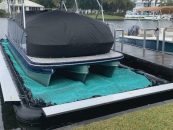Fabrics – fibre or synthetic – are common elements in the interior of a vessel. Cleaning fabrics can be conducted in two ways: steam (wet) cleaning or dry (solvent) cleaning. Steam cleaning is best used on any synthetic or wool products. It uses high heat, agitation, and chemicals to clean the surface. Dry cleaning uses chemicals and agitation only.
Steam cleaning upholstery only wets the surface and should never penetrate through the stuffing. If this happens, you will get brown stains (called water stains) on the fabric. These are some of the toughest stains to remove so it is best avoided. Steam cleaning is best left to a professional as damage to your upholstery can be severe if not performed correctly.
Dry cleaning uses a solvent that evaporates rapidly and evenly, and is mostly used on raw linen or lightly soiled upholstery. Agitation by hand or mechanical means ensure that encapsulation of dirt happens and is picked up in the cleaning medium.
What does this mean to you?
On a boat, the most common damage or soiling is from either food (including drinks) or water. When a spill happens, the first thing to do is to dry out the area as quickly as possible and wipe-up any residue. Dampen a white tea towel – it is imperative to use a white rag, as it prevents stain transfer – and lightly dab the affected area. On a wine stain, use a bit of salt on the affected area to help absorb any excess fluid. DO NOT AGITATE A WINE STAIN.
Water damage is almost sure to happen at some stage. The best way to treat a water spill is to dry it out as soon as possible. Do not use any chemicals on a water stain. If chemicals are used, these must be extracted completely to prevent damage to fabric, so it is best to have a professional conduct the cleaning.
If you already have a brown stain on your upholstery due to water, place a slightly damp white tea towel over the area, and leave to dry. This process will have to be repeated a couple of times to see an effect, but it is a safe and easy way to get rid of water marks.
Leather and vinyl are great on boats (if treated correctly) as they repel moisture rather than absorb it. The drawback is that marks and stains are easily visible. Further, the damage that occurs is usually more severe than on other material.
Leather needs more attention than synthetic material, but if looked after properly, it can have a lifespan that is as long (if not longer) as synthetics. Leather does not like water to pool or “rest” on it. Dry off water as soon as it comes on furniture. If your leather was treated correctly and the treatment has not worn off, there should be no lasting effects to a spill on leather. That being said, leather should be treated regularly. Some over-the-counter products are fine as long as they are used regularly and correctly. Make sure these products are both water-resistant and UV-protective. Cleaning is best left to a professional as the cleaning process will strip off any protection and the chemicals used can damage the leather.
Vinyl is great for outside use. It is tough and durable. It is generally treated the same as leather. The only difference is the protection needed must contain a softening agent and have very high sun-protection properties.
Marks on both leather and vinyl are best treated with a damp cloth and a bit of leather cleaner. Only treat the affected area and apply a protection layer when the area is dry. You will remove the protection layer if you clean the area so keep it as small as possible. If you do not keep good quality cleaners and protection products handy, the best practice is to leave it alone and get a professional to clean and protect your leather upholstery.
Feel free to call for advice. Mobile: 0484312966



























